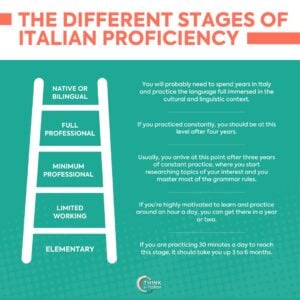What is il comparativo in Italian?
In Italian, we form the comparative using the words più (more) and meno (less).
Luca è più nervoso che arrabbiato.
Luca is more nervous than he is angry.
È meno divertente giocare a calcio che a tennis.
It is less fun to play football than tennis.
Let’s take a look at the other possible way of forming the comparative in Italian: più + adjective + che + second part of the comparison.
When to use più che and meno che?
We use più + adjective + che when:
- The second part of the comparison is another adjective.
Giorgio è più affascinante che bello.
Giorgio is more charming than he is handsome.
- The second part of the comparison is preceded by a preposition.
È più interessante andare a teatro che al cinema.
It is more interesting to go to the theatre than to the cinema.
- The second part of the comparison is a verb.
Nuotare è più stancante che camminare.
Swimming is more tiring than walking.
How to use più che and meno che?
The structure più ___ che ___ can also be used when the word between più and che is not an adjective.
We use it when:
Rosa è più una sorella che una semplice amica.
Rosa is more of a sister than just a friend.
- We compare two verbs or adverbs.
Mi piace più mangiare che cucinare!
I prefer to eat than to cook!
Practice with Quizlet
Here's a set of flashcards and quizzes to practice this grammar topic.Il comparativo: examples
Now that you’ve learned how to use the structure più + ____ + che correctly, let’s have a look at some more examples of this form of comparative.
Remember, with this structure, the first term of comparison does not have to be an adjective, but can also be a verb, adverb, or noun.
Secondo te, correre è più stancante che nuotare?
What do you think, is running more tiring than swimming?
Pensavo Lucio fosse più uno scienziato che un professore.
I thought Lucio was more of a scientist than a professor.
Ho più sete che fame!
I am more hungry than I am thirsty!
Caterina è più furba che bella.
Caterina is more cunning than beautiful.
Read more about how to use the more, the more and the less, the less and more and more, less and less.




















2 Responses
So when to use “piu/meno…che…” versus “piu/meno di”?
Are the 2 interchangeable?
Hi Anirudh, great question! The phrases “più/meno…che…” and “più/meno di” are not interchangeable in Italian. We use “più/meno…che…” when comparing two things directly. For example, “Luca è più nervoso che arrabbiato” (Luca is more nervous than angry). On the other hand, “più/meno di” is used when comparing quantities or amounts. For example, “Ho più di dieci libri” (I have more than ten books). So, the choice between the two depends on what you’re trying to express. I hope this clarifies your doubt. Feel free to ask if you have more questions!